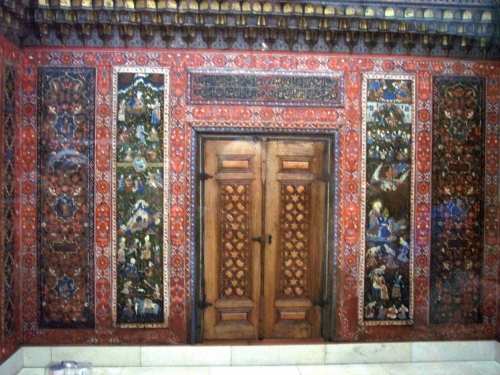The Aleppo Room: a lost world of cultural harmony

Jenny Farrell shows the poignant seasonal relevance of the wonderfully inclusive art in the Syrian Aleppo House.
With everything that is happening in the world at the moment, it might seem facile to think of this season as one of good will. And yet Christmas is as good a time as any to reflect on a magnificent piece of art, exhibited in the Berlin Museum of Islamic Art. It is a wood panelled interior of the reception room from an in early 17th century Aleppo House, which expresses supremely good will to all. What makes this so special and poignant is its cultural and religious inclusiveness.
A prosperous Christian citizen, the Armenian merchant Isa ibn Butrus (Jesus, son of Peter), in the town of Aleppo, commissioned the painted panels of the walls of the reception room in his house in 1600. This was the room into which his guests would first arrive, so it had a representative and expressive function.
The paintings in what is now known as the Aleppo Room are the oldest collection from a Syrian residential house from the Ottoman period. The Christian owner engaged craftsmen from the best workshops of the time to paint a variety of themes. (The name Halab Shah ibn Isa, one of the craftsmen, appears on the cornice.) These are based on Islamic book illustration of that time, floral and geometric designs, and are executed in the best Ottoman tradition. Christian themes from the Old and New Testaments, including a depiction of Mary with Child, have their place alongside courtly scenes based on Persian book illustrations. The selection of decorative Psalms, Arabic proverbs and Persian principles which frame these scenes deepen the impression of a community of different religious beliefs living together peacefully. The room is a visual expression of this harmonious diversity.

The central panels are located at the back of the room’s main section, to both sides of a wooden cabinet door set into the wall. Middle Eastern courtly scenes are painted on the left-side panel, including a royal sitting on a throne, a hunt and a hunting party with a prince holding a falcon. Old and New Testament biblical themes portrayed on the right-side panel involve Salome’s dance in front of King Herod, the Last Supper and the sacrifice of Isaac. What adds to the interest of these images is the fact that they reflect the Middle Eastern origins of Christianity and the natural inclusion of this religion into the regional culture. It makes complete historical and cultural sense to the Aleppo artist to depict the characters in the paintings in Middle Eastern dress.
Other panels inside the room display more individual illustrations from either Middle Eastern courtly and hunting scenes, or Christian subject matters. They also show illustrations of the Arab love story of Leila and Majnun of Nizami (1141–1202) from the Haft Paykar, or the Virgin Mary and Child, or Saint George. Fantastic and real animals are depicted alongside these.

The inclusivity of the themes of these paintings make these earliest surviving wall panels such a significant collection. They are evidence of a peaceful plurality of culture that could perhaps only have arisen in the Syrian trading town Aleppo.
In a world of growing economic inequality and exploitation, and the inevitable cultural accompaniments of suspicion, xenophobia and downright racism, it does not take a cynic to point out that such cultural inclusivity and harmony has been utterly lost, in a time when it is so badly needed for the survival not only of Syria, but of all of us.

Jenny Farrell
Jenny Farrell is a lecturer, writer and an Associate Editor of Culture Matters.
Latest from Jenny Farrell
- Poetry for the Many, an anthology by Jeremy Corbyn and Len McCluskey
- A hopeful vision of human renewal: the theatre of Seán O'Casey
- Art that's rooted in the upheavals of his time: Caspar David Friedrich, 1774-1840
- A Drive to Change the World: James Baldwin, Black Author, Socialist and Activist
- A woman's perspective on the invisible front: A review of 'The Shadow in the Shadow'
